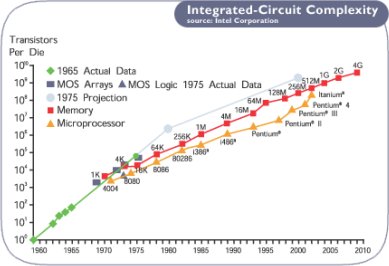Indirect Mind Uploading:
Using AI to Avoid Staying Dead
Paul Almond
page 8 of 13
The sort of increase in computing power that would be required to do this is one that we can expect to arrive at some time in the future if progress in computing science continues in any way like it has done so far. In 1965 CE, Gordon Moore published what is now widely regarded as a classic paper[1] observing that the number of transistors on a microchip doubled every twelve months. This is known as Moore’s law. If Moore’s law continues to hold even approximately true then we can expect this exponential increase in computing power to deliver massive computing resources in the foreseeable future.

Image 5: Moore's Law. Copyright Intel Corporation.
Pessimists could comment that there appear to be fundamental limits on semiconductor microchip fabrication. Microchips are made by projecting a photo-reduced image onto the surface of the chip and as smaller transistors are required the wavelength of the radiation required to do this decreases, making the radiation harder to focus. If progress with existing manufacturing methods continues for long enough we will eventually find ourselves with the problem of trying to focus X-rays. No viable method is known for focusing X-rays, nor is one likely to be available soon; this problem is known informally as the wall. Of course, progress might not even continue as far as this: the difficulty and costs could become prohibitive well before X-rays are needed. This, in itself, need not mean that improvement in computing hardware slows down for any appreciable period of time; such a problem will drive research into new ways of building computers and when the transfer to new forms of technology is made then progress could actually occur much more rapidly than is predicted by Moore’s law.
How much information would you need to preserve about yourself for indirect mind uploading to be viable? There is no easy answer; every item of data that is stored eliminates many hypothetical versions of you that would not match those criteria and "as much as possible" would seem to be the rule. A diary would be highly advisable, as would copies of any emails that you send and audio recordings. Video recording, both from roughly your own point of view and, occasionally, from cameras mounted in various places, if the equipment could be afforded, would be even better.
A person who was ambitious about getting "properly" uploaded could go even further by incorporating pulse readings and similar sorts of measurements. A DNA sample would probably help to eliminate minds that could not have resulted from your particular genetic code and preserving DNA for long periods of time is now quite cheap. Although current brain scans do not capture enough information to allow a sufficiently accurate computer model of the mind to be made, this does not necessarily mean that brain scans would be useless: if you really wanted to spend money, the data from occasional brain scans, stored with the other data about your life, might be significant in eliminating large numbers of possible minds that could not possibly have had those particular brain scan results in their pasts.
How the Model Could Be Generated
We will now look at how the archived data, documenting a person’s experiences and actions, might be used to construct a computer model. This discussion will be necessarily vague, because we have incomplete knowledge of how to make models. Generating models from observations is major problem in artificial intelligence, but our own brains are quite good at it, which suggests that solutions to modelling problems are at least possible. Nevertheless, it is possible to speculate now about how it might be done, and a possible method follows.
Footnote
1. Moore, G. E. (1965). Cramming more components onto integrated circuits. Electronics, Volume 38, Number 8. Retrieved June 22, 2003 from ftp://download.intel.com/research/silicon/moorespaper.pdf
(back to top)